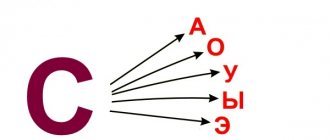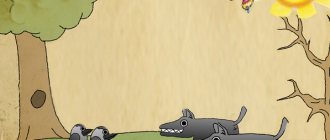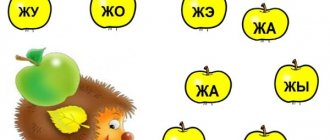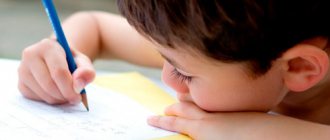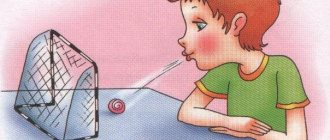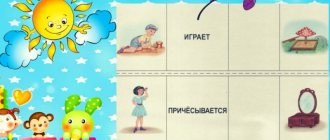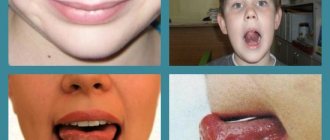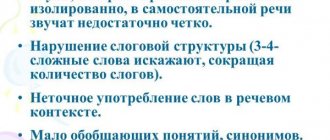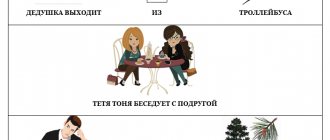Distinguishing the pronunciation of sounds in the absence of sound replacement
- First practice pronouncing that defective sound that the child used to have. You pronounce the words the way the child pronounced them before (that is, pronouncing the sound incorrectly), then correctly (sometimes vice versa). The child “guesses” when you pronounced the word correctly.
- The child must first pronounce words correctly, then the same way he pronounced them before (sometimes vice versa). You "guess" when he said it correctly and when he didn't. From time to time you will “make mistakes” (confuse correctly and incorrectly pronounced words), and the child must detect and correct these mistakes of yours.
- You pronounce the word the way the child used to pronounce it. He must “correct” your pronunciation - pronounce the word correctly.
- You pronounce a word correctly, and the child must repeat it after you the way he pronounced it before (defectively), and then “correct” his pronunciation.
- The child must first pronounce the word correctly, then the way he pronounced it before (defectively), then again correctly.
Distinguishing the pronunciation of sounds when replacing sounds
The work of distinguishing sounds will be described using the example of the sounds [s] and [w]. Expected situation: instead of the sound [w], the child pronounced the sound [s]. Pre-familiarize your child with the corresponding letters. Other symbols can be used: for example, the sound [s] (old pronunciation) may be indicated by a black circle, and the sound [w] (new pronunciation) may be indicated by a red circle.
Differentiation of sounds in an isolated position. When you show your child the letters [s] or [sh] (or symbols that replace them), he should pronounce the corresponding sounds.
Differentiation of sounds in syllables. You pronounce syllables very slowly, among which there are syllables with the sounds [s] and [sh], [ra], [shi], [lo], [su], [re], [sha], etc. Bogda child hears one of the differentiated sounds, he must show you a picture with the corresponding letter and name the sound that he heard.
Differentiation of sounds in words.
- You slowly pronounce words where the sounds [s] or [w] are at the beginning of the word (garden, son, fur coat, sleep, step, etc.), the child must name the sound with which the word begins. Make sure that you do not alternate words first with one sound, then with another, in this case the child will stop paying attention to the verbal material and will simply begin to raise his hand through the word.
- You pronounce simple words where the sounds [s] or [w] are in the middle of the word: porridge, braid, mustache, soul, ears, fox, etc. The task for the child is the same as in the previous case.
- You pronounce simple words where the sounds [s] and [w] are at the end of the word: forest, ladle, fox, mouse, shower, cape, etc. The task is the same as in previous cases. Be sure to ensure that among the words there are no words in which both differentiated sounds are simultaneously present.
- The child must come up with words that begin with the sound [s] or [sh].
- You name pairs of words that differ from each other in only one sound ([s] or [sh]), for example: bowl - bear, koska - cat, helmet - porridge, cape - mouse, etc. Having named a pair of such words ( for example, a braid is a cat), you ask the child questions, for example: “What can be braided on a girl’s head?”, “Who says meow?” The child must answer your question using the correct word.
- The child should repeat after you words that contain both differentiated sounds at once: highway, land, boxwood, pole, etc.
- The child should repeat after you words in which there are both differentiated sounds (as in the previous exercise) and words in which the same sound occurs twice (for example: kebab, nipple, checkers, etc.). In the latter case, the child often replaces the repeated sound with another (for example: shashlik - sashlyk or shashlik, soska - fry or shoska, etc.).
Differentiation of sounds in sentences. The child should repeat after you sentences in which differentiated sounds occur in large numbers, including in one word: Sasha is walking along the highway. The cat ate the mouse. Boxwood grows in the garden.
Differentiation of sounds from pictures
- The child must arrange the pictures whose names contain the sounds sounds [c] [w] into two piles: one with the sound [s], the other with the sound [w].
- The child must choose from a bunch of pictures those whose names contain the sound [s] (among the pictures there should also be pictures whose names contain the sound [w]). Then from the same pile you need to select those pictures whose names contain the sound [w].
Automation of sound [L]. "Naughty Kitten" | Speech therapist via Skype
Content
Sound automation game [L] “Naughty Kitten”
(based on the book by L.N. Shinkarev “Games for automation and differentiation of sounds in preschool children”)
Purpose of the game:
- Automation of sounds [ C ], [Z], [Sh], [Zh], [R], [L], [L].
- Differentiation of sounds [ C ] - [Z] - [SH] - [Zh]; [R] - [L] - [L].
- Development of the lexical and grammatical structure of speech, in particular, training in the use of case constructions
Material:
Circles made of colored cardboard, painted to look like balls
".
Pictures of balls are cut out separately and glued.
Rules of the game "Kitten - Naughty"
The balls are laid out on the table. We explain to the child that the kitten scattered grandma’s balls. To prevent grandma from being upset, they need to be collected.
You can collect the balls in any beautiful box, or place them near the grandmother sitting in the chair, shown in the story picture.
To practice distinguishing (differentiating) sounds, you can ask the child to collect balls with pictures containing different sounds (for example, the sounds [C] - [Ш] or [Р] - [Л]) in different piles or different boxes.
You can ask the question: “What pictures did you collect?”, “What picture did the kitten hide?”, training in the use of the accusative case.
On the back of the glomeruli there are object pictures that the child must name correctly.
Game application: see below
The game was prepared by:
teacher speech therapist
Lyudmila Fedirko
MDOU Kindergarten No. 1 village. Aksha
I advise you to read more on this topic
logopedrunet.ru
TEXTS AND PICTURES FOR AUTOMATION AND DIFFERENTIATION OF SOUNDS [l], [l], [r], [r] Issue 4
Transcript
1 N. V. Nishcheva TEXTS AND PICTURES FOR AUTOMATION AND DIFFERENTIATION OF SOUND [l], [l], [r], [r] Issue 4 St. Petersburg “CHILDHOOD-PRESS” 2018
2 BBK N 71 N 71 Nishcheva N. V. Texts and pictures for automation and differentiation of sounds [l], [l], [r], [r]. Educational and methodological manual. Issue 4. St. Petersburg: LLC PUBLISHING HOUSE “CHILDHOOD-PRESS”, p., color. ill. (Speech therapist's office). ISBN The manual contains pictures and texts to automate and differentiate those sounds whose pronunciation causes the greatest difficulties for children. Addressed to speech therapists of children's preschool educational organizations and school speech therapy centers, kindergarten teachers, parents of children with speech development problems. ISBN Nishcheva N.V., 2022 PUBLISHING HOUSE “CHILDHOOD-PRESS” LLC, design, 2017
3 From the author Recently, an increasing number of children have problems with sound pronunciation problems. More often than others, the pronunciation of whistling sounds ([С], [С], [З], [З], [Ц]), hissing sounds ([Ш], [Х]), sounds [Ч], [Ш], sonorant sounds is disrupted ([Р], [Р], [Л], [Л]) and iotated sounds. It seems to us that the production of sounds whose pronunciation is impaired in a child should be entrusted to a specialist, but the work on automating (consolidating) the sound can easily be carried out by parents under the guidance and supervision of a speech therapist. You can start working on automating the pronunciation of a sound only if the child correctly pronounces the given sound in isolation. This work requires caution and gradualism. Each delivered sound is first automated in syllables of various types, then in words, and only then in various types of expanded speech (in sentences, nursery rhymes, phrasing, poems, texts rich in automated sound). This manual presents texts for automation and differentiation of sounds of different groups. The process of automating sound in text is the most difficult stage of the work. You can move on to this stage only when the child correctly pronounces the corresponding sound in syllables and words, phrases and nursery rhymes, as well as in sentences. With children who can read, texts can not only be spoken, but also read. When starting to memorize or retell texts, it is necessary to work with the child on the pronunciation of words containing an automated sound. Based on the principle of phonetic accessibility, teachers and parents should select texts for sound automation that do not contain sounds that have not yet been delivered or have not been automated by the child. When starting to work on the text, be sure to instruct your child that his speech should be clear, unhurried, with an accented pronunciation of the automated sound. Differentiation (discrimination) of a given sound with other sounds that are articulatory and acoustically similar to it can be started only when the newly delivered sound is pronounced correctly by the child in any sound combination. In this work, one should rely on speech-motor, speech-auditory and visual analyzers. Pictures for texts can act as visual support. You can also use pictures to compose stories with your child based on key words. The sequence and gradual complication of speech exercises when differentiating sounds is the same as during automation: first we distinguish sounds in syllables, then in words, then in sentences, nursery rhymes, phrasing, poems, texts rich in differentiated sounds. It is gradualness and consistency that then ensures the differentiation of sounds in spontaneous speech. When starting work on automation and differentiation of sounds, it is necessary to take into account the nature of the pronunciation disorder, the level of intellectual and general development of the child.
4 4
5 5 Automation of sound [L] Volodin's joke Nikolai was going to school. The dog Pilot ran after him and dragged a bag in his teeth. Volodya saw this and wanted to play a trick on Nikolai. He approached the Pilot and gave him a bone. The pilot took the bone and left the bag. Volodya thought: “Nikolai will be surprised when he sees a bone in Pilot’s teeth instead of a bag.” Words whose pronunciation should be practiced to retell the text: Nikolai, walked, to school, ran, Pilot, dragged, saw, Volodya, wanted, over Nikolai, approached, to Pilot, gave, took, left, thought.
6 12
7 13 Differentiation of sounds [L] [L] At the festival Alik and Ilya went to the cartoon festival. The boys saw cartoons about Leopold the cat, Snow White, Cinderella, the Nutcracker, and Bambi the deer. The festival was fun. The boys laughed heartily. Words whose pronunciation should be practiced to retell the text: Alik, Ilya, went, to the festival, cartoons, boys, saw, cartoons, Leopold, fawn, at the festival, fun, laughed.
8 Educational publication Nishcheva Natalia Valentinovna Texts and pictures for automation and differentiation of sounds [l], [l], [r], [r]. Issue 4 Editor-in-Chief S. D. Ermolaev Editor V. M. Nishchev Artist P. Yu. Blagov Proofreader N. I. Grigorieva Designer A. V. Chipchikova PUBLISHING HOUSE “CHILDHOOD-PRESS” LLC, St. Petersburg, PO Box 45. Tel.: (812) Representative office in Moscow: MOO "Razum", Moscow, Ivanovskaya st., 34. Tel.: (499), Signed for printing Format / 16. Offset paper. Offset printing. SchoolBook headset. Conditional oven l. 1.5. Circulation 1900 copies. Order Printed in the printing house of LLC "First IPH" St. Petersburg, st. Mendeleevskaya, 9. Tel.: (812) Book by mail service: AROS-SPb LLC, St. Petersburg, PO Box 37 Tel.: (812) ,
Automation of sound L
We begin automating sounds in words only after the child clearly pronounces an isolated sound and can pronounce it correctly in syllables. We name words, highlighting the automated sound with our voice.
We pronounce the words slowly, pronouncing them clearly. It is advisable to repeat the same word 2-3 times.
Articulatory posture: lips are open, it is better to stretch them into a “smile”, so that the teeth are exposed, the teeth are open, the tongue is free, spread out like a “scapula”, the tip is raised to the alveoli or necks of the upper incisors and forms a tight connection with them, the lateral edges of the tongue are lowered and form gaps with the molars through which air passes, the root of the tongue is raised.
Pronounce clearly the sound [l] in syllables, first vertically, then horizontally: la al ala lal lo ol olo lol lu ul ulu lul ly yl yly lyl
We fix the pronunciation of the sound L at the end of words:
oval glass channel collapse pencil case basement station metal capital dump truck angle prick table trunk falcon goat cauldron church football buffalo knot woodpecker Pavel ashes torch newcomer donkey chair basketball
Exercise “Listen. Remember. Repeat"
Ball - small - hall. Collapse - metal - glass. Digged - nodded - yawned. Vol - goal - count. Cauldron - goat - goldfinch. Donkey - cover - football. Torch - woodpecker - ash. He made noise - hissed - walked.
The sound L at the end of a word in a series of words
List of words: Hall, canal, glass, basement, Ball, pencil case, coral, jackal.
List of words: Table, cauldron, goat, goldfinch, Ox, donkey, football, cover.
We fix the pronunciation of the sound L at the beginning of words:
varnish shop lama lamp noodles bast weasel patch palm avalanche swallow lamp forehead crowbar dexterous boat elbow elk vine catch break chunk tray meadow moon puddle meadow Luka lawn bow splint magnifying glass bast crafty
Exercise “Listen. Remember. Repeat"
Bench - paw - lamp. Delicacy - boatman - shopkeeper. Elbow - spoon - boat. Bow - magnifying glass - puddle. Lusha - hole - ray.
The sound L at the beginning of a word in a series of words
List of words: Paws, boat, light bulb, elbow, bast shoe, swallow.
List of words: lily of the valley, bench, lamp, spoon, elk, shovel, varnish, palm.
List of words: bow, rays, moon, lawn, horse, lotus, forehead, husky.
We fix the pronunciation of the sound L in the middle of words:
saw bowl spinning top rock shark fist salad robe talent malachite beam squirrel roll jackdaw stick fork shelf needle violet hairpin pin bottle column tent shovel broom salt shaker lapdog jump rope piggy bank parcel stretcher catch weed chop grind
hair head gold milk hunger voice cold ear balloon swamp straw column cold rinse half hammer
boulder cleaver naughty sheepskin coat pigeon dove dove beluga Kaluga acorns deck
pitchfork saw vacation scarlet cute white cradle wormwood smile Exercise “Listen. Remember. Repeat"
Cases - ash - saw. Robe - salad - rock. Ear - voice - hair. Pin tents are sleds. Swamp - Volodya - breakdown. Hungry - cold - well. Smile - cobblestone - bagpipes.
The sound L in the middle of a word in a series of words
List of words: school, apple, spinning top, soap, milk, saw.
List of words: balcony, cap, needle, shelf, Violet, jackdaw and T-shirt.
Even more picture material for automating sounds on the Sound Automation page.
logopediy-dly-detey.ru
Games for differentiating sounds S-Sh
Distinguishing the sounds S-Sh by ear and in pronunciation.
Author: Marina Alekseevna Durneva, speech therapist teacher, MBDOU kindergarten No. 17, Kamensk-Shakhtinsky. Goal: differentiation of sounds Zh-Z. Objectives: 1. To develop in preschoolers correct sound pronunciation, the ability to differentiate the sounds S-SH in their speech, and to use them correctly. 2. Using a didactic game, diversify the work on consolidating correct sound pronunciation and interest children. Description: The child mixes the sounds S-Sh most often, not only by ear, but also in pronunciation.
Work on differentiating the sounds S-Sh helps clearer, more conscious pronunciation in general, and is also the basis for literacy in writing. These games can be conducted by both a speech therapist and a teacher. This work will be useful to speech therapists, speech therapists, educators, and parents. Contents
First stage Discrimination of sounds S-Sh in isolation, in syllables and words.
1. Differentiation by ear of the sounds S-Sh in words.
Listen carefully to unfinished sentences.
From a pair of similar-sounding words, name one that is suitable in meaning. Explain its meaning. They put it in a bowl... (porridge or helmet).
The firefighter puts on ... (porridge or helmet). Sleeps sweetly in the den... (bowl or bear). On the table with salad... (bowl or bear). Our cat's nickname is... (Mashka or mask). Porridge should be ... (naughty or salted). The wrestler has great ... (awl or strength). There is a big... (gang or cod) in the bakery. 2. Differentiation in hearing and pronunciation of isolated sounds S-Sh. We play different onomatopoeic games with children.
Like: - The forest is noisy (they shake their arms up and pronounce the sound Sh-Sh-Sh in a drawn-out manner). — Pump (imitate the movements of a person pumping a tire, pronouncing the sound S-S-S). - Snake (put your palms together, move them from side to side and hiss). - Water is pouring from the tap - wash your hands (we imitate hand washing and whistle - water is pouring). - The tire is flat (Sh-sh-sh-sh - we squat), we need to pump it up (exercise “Pump”.) 3. Differentiation of sounds S-Sh in straight syllables with the same vowel sounds.
The “Repeat” game is to clearly pronounce the syllables (first 2, and then 3 syllables).
First, an adult acts as the leader, and then you can invite the child to ask syllables, and other children or the teacher repeat. The task of the child leader is to notice mistakes and correct them. sa-sha so-sho su-shu sy-shi sha-sa sho-so shu-su shi-sy sa-sha-sa so-sho-so su-shu-su sy-shi-sy sha-sa-sha sho -so-sho shu-su-shu shi-sy-shi 4. Differentiation of sounds S-Sh in straight syllables with different vowel sounds.
The game “Repeat” is also played on these syllables
sa-sho su-shi sy-sha se-sho shu-sa shi-so sha-sy so-sha su-shi-sa sy-sha-su se-sho-sa shi -su-sho sho-sy-shu she-su-sho sha-su-shi shu-sy-she 5. Differentiation of sounds S-Sh in words.
Game “Memories” - take the pictures that the children named when automating each of the sounds, mix them up and lay out 6 pieces in front of the child. While laying out, the child names each picture. After this, the child remembers all 6 pictures and closes his eyes. The teacher removes the 1st picture, and the child, opening his eyes, must name which picture the teacher took away. First, we take pictures where the words contain only 1 sound. For example, cheese-jackal-salad-bag-bag-hat. Then words with both sounds are taken, such as sun-drying-six-weightlifter-highway-old lady. Second stage Distinguishing the sounds S-Sh in sentences and coherent speech.
1. Differentiation of sounds S-SH in independently composed sentences.
Game "Come up with a proposal."
This game is played on the material of the same pictures that were discussed earlier. The child is given a picture and asked to come up with a sentence using this word. If you are working with a group of children, you can arrange a competition to see who can come up with the most suggestions. For each sentence made, a chip is given, then the result is calculated. Whoever has more chips wins. 2. Differentiation of sounds S-Sh in rhymes.
The “Repeat” game is to repeat rhymes after the teacher, first slowly and then quickly.
Take care of your nose in the extreme cold.
The locomotive is breathing steam, steam is puffing from under the wheels. They gave Sasha porridge in a bowl, she gave all the porridge to her pussy. Ivanushka was swimming near a gray pebble. Owls, jays and cuckoos made noise at the edge of the forest. Masha cooked delicious porridge. Pies with peas are good for the road trip. Near a large hut, an elephant rocks a baby. 3. Differentiation of sounds S-Sh in funny dramatizations. Game "Theater".
It is carried out in pairs: child-child or child-adult. To depict the role, headband masks have been prepared in advance. We put them on and act out a poem. The child’s task is not only to portray his hero, but also to pronounce all the words correctly. - Vacuum cleaner, vacuum cleaner!
Where are you sticking your nose? - Shu-shu-shu, shu-shu-shu, I breathe your dust! - Mouse, mouse, why aren’t you sleeping? Why are you rustling straws? - I'm afraid to fall asleep, sister, I'll dream about a mustachioed cat! — The nimble Mishka was walking through the forest, and a cone fell on him. - And on us, and on us, let the pineapple fall! 4. Differentiation of sounds S-Sh in stories. We read the story, then have a conversation and ask the child to retell it.
NEIGHBOR Sasha walked to school, and behind him walked the dog Fluff and, as always, carried Sasha’s bag. Sasha was proud of his dog. No one had such a smart dog! Sasha quickly walked towards the school, did not stop and did not look back. At this time, Sasha’s neighbor, Mishka, came up to Cannon and handed the dog a bone with meat. Fluff dropped the bag, grabbed a large bone and went after Sasha again. And the naughty Misha took Sasha’s bag and said to himself: “I’ll look at Sashka when he comes to school with a bone and sits at his desk!” HEAVY BURDEN A pig once bought a bag of acorns from a bear. The pig is carrying a sack, and somehow the load seems weightless to her. “The bear deceived me,” the pig decided, “he filled half the bag!” The pig walks further and gets tired. The bag seems heavier to her with every step. “No, the bear didn’t deceive me,” the pig thinks, “he filled the bag!” The pig is walking again, and it is too much for her to carry the heavy bag. The pig threw the bag, stood up and said: “Why did this bear pour two bags for me instead of one?!”
We recommend watching:
Didactic game for children 5 - 7 years old Speech therapy leisure in the preparatory group Winter tongue twisters and poems for automating and differentiating sounds Didactic game for preschoolers 4-7 years old
Similar articles:
Tongue twisters for practicing the sounds of the Russian language
Stories with pictures to automate the sound “L”
Stories with pictures to automate the sound “L” will help children learn to correctly say the sound in sentences and easily remember the text for retelling.
View the contents of the document “Alla and Glory.”
View the contents of the document "Squirrel and Woodpecker"
View the contents of the document "Wolf Cubs"
View the contents of the Blue Lamp document
View the contents of the document “A Doll for Lana”
View the contents of the document “The Moose and the Calf”
Viewing the contents of the document “Luntik and Mila”
Viewing the contents of a Spider-Man document
kopilkaurokov.ru
Example words for differentiating sounds
Words for differentiating sounds [s - w]: Sasha, highway, land, drying, six, pole, wool, nimbleness, duchess, fascist, procession, knuckle, rustle, boxwood, weightlifter, wasteland, eared, chance, shepherdess, machinist, hornet, kebab, checker, cone, nipple, sausage, gopher, samsa, swineherd, space. Words for differentiating sounds [z - zh]: rod, lighter, yellowness, life, clamp, ignition, iron, healing, makeup artist, zhizha, ground beetle, excitement, splinter, gap, sweetheart, arrogant, zrazy. Words for differentiating sounds [ts - s]: tank, citrus, kingdom, stairs, desert, hotel, station, specialist, sun, village, abscess, oyster, process, male, tsatsa, tsetse fly, concept, Cicero, queen, stanzas , Stae, pacifier, iconostasis. Words for differentiating sounds [l - r]: roll, eagles, throat, lorgnette, Lara, overlock, Karl, Clara, drill, caravel, coral, den, marmalade, carnival, Frol, flora, formula, casket, charlatan, corporal, emergency, rapier, spring, castling, Aurora, resort, bell, balalaika, scrap metal, puzzle. Words for differentiating sounds [l - i]: husky, bark, apple, Yalta, balalaika, pancakes, blanket, spinning top, Christmas tree, slide, puff pastry, Dalai Lama, Jamaica, egg, bell, puzzle. Words for differentiating sounds [l' - i]: ruler, watering can, spruce, lily, beehive, glue, train, alley, manger, sculptor, Julia, hookah, Leah, skiff, lithium, alliance, flute, rut, Jamaica, egg , Lilya, Lala. Words for differentiating sounds [p - i]: paradise, swarm, Paradise, brightness, fair, yoke, region, edge, cut, troika, Ermak, moira, saury, yurt, fireworks, Beirut. Words for differentiating sounds [p' - th]: prairie, reika, Korean, Yuri, Guria, aria, Maria, boyar, mayor's office, Austria, fury, remake, Friedrich, refrain, referent, scrape, secretary, crossroads. Words for differentiating sounds [р' - l']: solarium, malaria, cavalryman, April, cleric, coppice, pilgrim, grill, charm, lyrics, prel, tide, healer, binding, quail. Words for differentiating sounds [t' - h]: teacher, bird, flow, seal, mosque, buckshot, first aid kit, reading, quarter, chick, respect, shadow, aunt, bowstring, black grouse, dot, scarecrow, why, drawing, tap dance .
Sound table for the sound L
| Words - hints: | elephant, | needle, | shark, | t-shirt, |
| dress, | Horse, | broom, | squirrel, | |
| donkey, | Christmas tree, | wolf, | Spoon, | |
| Onion, | crocodile, | Shovel, | bee |
1. Name all the objects in order “snake”, starting with the picture with an asterisk * (elephant, needle, shark, T-shirt, squirrel, broom, horse, dress...)
2. Place a chip on each item (you can use a button or a toy - “kinder”) and first add to the named item the phrase “I got up” :
I stood on an elephant I stood on a needle I stood on a shark, etc.
3. Name objects in pairs so that a living object is paired with a non-living object. For example, an elephant has a needle, a shark has a T-shirt, etc.
(pictures are selected in pairs: living object - inanimate object).
4. Name all the objects, adding living - non-living : elephant - alive, needle - non-living, etc.
5. Name the object on which you place the chip first in the SINGULAR , then coordinate it with the numerals TWO, FIVE : one elephant, two elephants, five elephants; one needle, two needles, five needles, etc.
6. Name each item in a diminutive form, if possible:
elephant - elephant, needle - needle, etc.
7. Color living objects yellow, inanimate objects blue.
8. Show and call elephant - yellow, needle - blue, shark - yellow, etc.
9. Name what is in the upper right corner; in the lower left corner; in the lower right corner; in the top left corner; in the top row second in a row; in the bottom row third in a row; first in the second row; between, above..., under... etc. (the task can be of any complexity).
10. Come up with one sentence for each subject.
(complicated version of the task: come up with sentences using two words from the sound table, for example, elephant and needle - elephant threads a needle)
Make sure you pronounce the L sound correctly!
Author of the material: Inga Didkovskaya
Also on the topic: “Automation of sounds”
logoped18.ru
Sound automation [L]
The hard consonant sound [L] is colored blue (hard consonant). Vowel sounds are colored red.
The sound [L_] is pronounced for a long time and only with a motionless tongue (see articulation of the sound [L]).
1) Pronounce (read) syllables with the sound [L_]
Sample: al__, ol__, st__, yl__, el__, il__, el__, yol__, yul__, yal__
2) Pronounce (read) words with the sound [L] at the end
Sample: floor__, y-goal__
|
|
|
|
|
3) Pronounce (read) words with the sound [l] in the middle
Sample: floor, and head
|
|
|
|
4) Pronounce (read) the syllables L__A, A__O, L__U, L__Y, L__E
5) Pronounce (read) words with the sound [L] at the beginning
Sample: l__ak, l__a-pa
|
|
|
|
|
6) Pronounce (read) words with the sound [l] in the middle
Sample: ka-l__ach, sa-l__at
|
|
|
|
7) Pronounce (read) syllables
Sample: k-l__a, k-l__o, k-l__u, k-l__y
|
|
 Pronounce (read) words with a combination of consonants with the sound [L]
Pronounce (read) words with a combination of consonants with the sound [L]
Sample: f-l__ag, p-l__a-val__
|
|
|
|
9) Pronounce (read) words with two sounds [l]
Sample: f-l__ag, p-l__a-val__
|
|
|
|
10) Pronounce (read) phrases
Sample: SAMPLE: White ha-l__at
- Blue dress.
- Bright moon.
- Bad boat.
- Yellow scarf.
- Broken saw.
- Cold basement.
- Hungry wolf.
- Thick stick.
- Heavy hammer.
- Ripe strawberries.
- A warm coat.
- A spiky tree.
- Tin soldier.
- Golden ear.
- Blue eyes.
- Silk blouse.
- Deep well.
11) Conjugate sentences
- I ate milk noodles.
- I bought a notepad and chalk.
- I broke my bike.
- I was sailing on a boat on the waves.
- I ate ripe strawberries.
Sample:
- I drank cold milk.
- You drank cold milk.
- He (she) drank cold milk.
- We drank cold milk.
- You drank cold milk.
- They drank cold milk.
12) Say (read) sentences
Sample: Mi-l__a pi-l__a mo-l__o-ko
- There was a table next to the table.
- Volodya went to the collective farm.
- Alla bought a white dress.
- Mila carried the blue flag.
- A boat floats on the waves.
- Klava clapped her hands.
- Klusha swept the floor.
- The elephant has white tusks.
- The squirrel was sitting near the hollow.
- Klava bought onions and beets.
- Mila ate strawberries from a basket.
- Nikolai broke his bike.
- Volodya forgot where he put his pencil case.
13) Pronounce (read) pure sayings
- He sat down and ate everything.
- Near the bell stake.
- Klava deftly chopped the onion.
- Mom didn’t spare soap; mom washed Mila with soap.
- The stake is near the table, the table is near the stake.
- Polkan pushed the stick with his paw.
- Alyonka sat down in the corner - Alyonka had a lot to do.
- The nightingale is not great, but its voice is golden.
- Put off idleness, but don’t put off doing things.
- A cap under a cap, a cap under a cap.
- Here the cheerful bun rolled like a ball.
- Fyokla’s beets were wet and dry.
- Slava swam on a raft and caught roaches from the raft.
14) Pronounce (read) and retell the text
Naughty
Mila had a cat. He was completely white. Mila named him Belyak. Belyak was a big naughty man. One day Mom was knitting new socks for Mila. There was a ball on the table. Mom left the room and left the ball on the table. The white hare jumps onto the chair, from the chair onto the table, and let’s push the ball with his paws. The hare pushed and pushed the ball and tangled all the threads. Mila entered the room, saw a ball on the floor and said: “Oh, what a naughty man you are, Belyak!”
15) Say (read) poems
White snow, white chalk, The white hare is also white. But the squirrel is not white, the squirrel was not white.
Grandfather planted onions and grew an onion. The grandson saw the bow and tore off the forelock of the bow.
Klava deftly chopped onions, Lala washed the floor and shelves, Volodya knocked out the dust, Valya hammered nails, Kolya merrily sawed, Anatoly washed the forks, and little Sveta ate sweet candies.
- White hare, white hare! Where did you run after the bast? The white hare answered: “I didn’t run, I galloped.”

